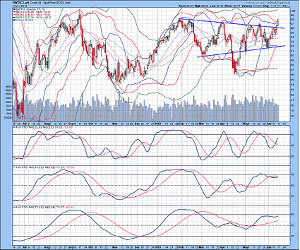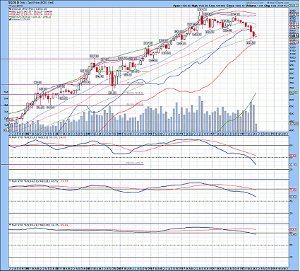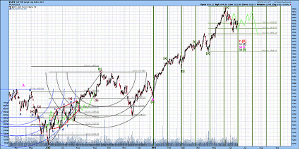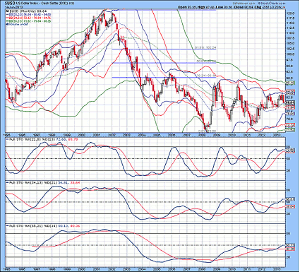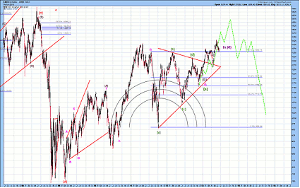The Contracting Fibonacci Spiral is a time-based cycle that only calls market tops based upon Fibonacci theory, according to David Petch of SafeHaven.com, and he details what it says about the US dollar, oil, gold, and stocks right now.
It is nearing two years since I first published an article describing a theory titled Contracting Fibonacci Spiral (CFS). For further information, simply Google "Contracting Fibonacci Spiral" and a plethora of articles should be listed to provide a more thorough description. Further to this, I published an article in the April 2013 issue of Technical Analysis of Stocks and Commodities (Submitted in October 2012) to attempt to bring more mainstream exposure to this concept.
In a nutshell, the theory indicated important tops of 1966, 1987, 2000, 2008, with the next sequential date due in 2013. The ideal date was December 27, 2012, but a 5% extension in time generated a date of May 21, 2013. The broad stock market indices topped on May 22, 2013, which is either a fluke or is following the CFS, but with an extended time post for this move. The next CFS date is three years away and has already been determined and posted on our site.
Historically, whenever a CFS time post has been reached, a subsequent sharp correction in the market occurs. It is important to understand that this cycle provides no indication for how long a correction can last. The 1966 top saw a correction last for over 15 years, while the 1987 top saw a very sharp, yet short correction. I would highly recommend everyone try to get a copy of the article in the April issue of Stocks and Commodities Magazine, because it provides a complete picture of this theory.
Lowry's has the stock market in a correction phase at present, with expected strength in the stock market for the remainder of 2013. One thing I can comment about the CFS is that if for some reason their was a "skip" in the rhythm of this cycle, then the 2016 top would represent a very important top that would subsequently find a very sharp correction. In today's report, I have included five different charts that help to paint a picture about what appears to be developing.
To quickly summarize for those who do not wish to delve into the technical analysis, here is what I see:
The price of oil appears set to rise to at least $111/barrel due to a few different technical factors. Rising energy costs will result in a decrease in disposable income for the consumer that would result in a gradual slow down in the economy.
The monthly chart of gold remains bearish with examination of stochastics, which suggests the bigger picture is a deflationary back drop, which would impact everything ex the US dollar.
The short-term Elliott Wave count of the S&P 500 Index has one more leg up to at least retest the May 22, 2013, high no later than Thursday this coming week and should top out by mid July. A rounding top is expected to continue to develop over the summer.
NEXT PAGE: The US Dollar & Oil
|pagebreak|The monthly chart of the US Dollar Index is showing a building trend for a move to the upside. The sharp move down this past month was not expected and altered the wave structure to indicate a more gradual rise rather than a sharp move that charts were indicating.
The XOI Elliott Wave count has followed patterns to the highest degree for everything that I track, and it is pointing to a top in October 2013. While the energy sector rises, it is expected that weakness in other sectors will see a rotation into energy, which will merely extend the rolling top.
The following charts will illustrate the points mentioned above and what to expect over the coming months.
The daily chart of oil is shown below, with a convincing breakout of an upper triangular trend line that has been developing since February 2013. This created an inverse head-and-shoulders pattern that has a measured move to $111/barrel, which makes any oil related ETF a buy. Full stochastics 1, 2, and 3 are shown below in order of descent, with the %K above the %D in 1 and 3 and beneath the %D in 2. With the %K in stochastics 2 and 3 appearing to be hooking up, expect another 3-4 weeks of further sideways to upward price action before any sort of a top is put in place.
Rising oil prices will translate into higher prices for any processed item or goods requiring transportation (food, clothing, manufactured goods etc.), which could put the breaks on the economy. The UFC is in Winnipeg Manitoba tonight (where I live) so this is probably the most anyone in the US would know about this city. Gasoline prices are $1.35/L (L = Litre) and there is talk that it could reach up to $1.50/L. There are 3.78 US gallons per L, so doing the math, it is easy to see that we are paying over $5/US gallon up here in the Great White North, with oil prices at $96ish/barrel. If oil goes to $110/barrel, then $1.50-1.60/L is in the cards. Energy prices are one of the key items that will keep an economy running or put on the brakes, so it will be very important that oil prices do not overextend. Otherwise, another recession would likely be triggered.
Figure 1
The monthly chart of gold is shown below, with a price excursion beyond the lower 21 MA Bollinger band for the third consecutive month. Full stochastics 1, 2 and 3 are shown below in order of descent, with the %K beneath the %D in all three instances. When gold took out the two-year horizontal support back in April, it changed the dynamics of this market, with lower prices likely in the not too distant future. The %K in stochastic 1 is still headed lower and has provided no indication that a bottom has been put in place.
NEXT PAGE: Gold and Stocks
|pagebreak|Although an oversold condition is developing, it could still take anywhere up to 6-8 months before an extremely oversold condition finally results in a move to the upside. If the price of gold were to head lower, it could result in people being forced to liquidate, which in turn could drive prices lower. The general backdrop of the economy suggests deflation as people must now start paying down debt. If I were to summarize what lies ahead, a drop to $1000-1100/ounce is highly probable, followed by an 8-12 month rise by $400-600/ounce and then one leg to at least retest the lows, maybe worse. The currency crisis that lies ahead will be resolved by gold bullion, and based upon the CFS, it appears that some time between mid-to-late 2015 into 2020 is likely to be the period of time when extreme prices in gold that have been discussed over the past decade occur.
Figure 2
The mid-term Elliott Wave count of the S&P 500 Index is shown below, with the thought pattern forming denoted in green. Based upon this count, a bottom is due on Monday or Tuesday, followed by a rise into mid-July to either at or below the May 22 high. If this pattern is correct, then a market top should be confirmed and should be followed by a series of higher lows as the broad stock market indices begin to roll over.
We were bullish from 2009 until May 2013, so the Contracting Fibonacci Spiral theory should at least be respected for what potentially could occur. Again, if it were by chance to skip this time post, then the aftermath of a 2016 top would be very intense to the downside. With the CFS, it indicates market tops and with the next one due in 2016, there in theory should be a decline ranging anywhere from 30-50% between now and then, followed by another strong move to the upside. This is why caution should be exercised at this point in time...the downside may not occur, but then again it might. Remain alert with respect to the broad stock market indices at this point in time.
Figure 3
The monthly chart of the US Dollar Index is shown below, with Bollinger bands not providing any real clear indication of trend. Full stochastics 1, 2 and 3 are shown below in order of descent, with the %K above the %D in all three instances. Extrapolation of the %K in stochastics 1 and 2 have sideways price action that conforms to the market price action of the past year.
With rising oil prices, it fits with the inverse correlation that it has to the US Dollar. There are other factors, such as supply and demand, political stability, conflicts around areas that produce the majority of the globe's oil supply etc., so rising prices for oil have many different dials that help to gauge how high prices rise...the US dollar is just one of them. The expected trend of the US dollar after its correction is complete is to head higher.
The long-term Elliott Wave count of the XOI is shown below, with the thought pattern forming denoted in green. The pattern broke out of a triangle, with wave (C) thought to be forming at present. If this pattern is accurate, then a top is not expected until sometime around October 2013. This scenario fits well with rising oil prices, which in turn raises profits of energy companies.
Figure 5
So, out of everything that I can see, oil and related stocks appear to have the best short-term potential profits.
By David Petch, Contributor, SafeHaven.com

